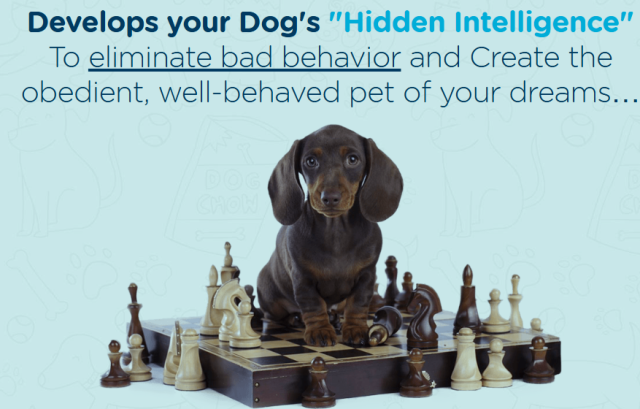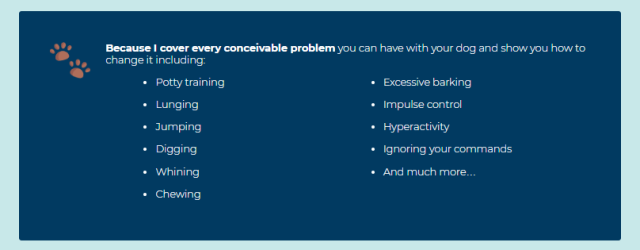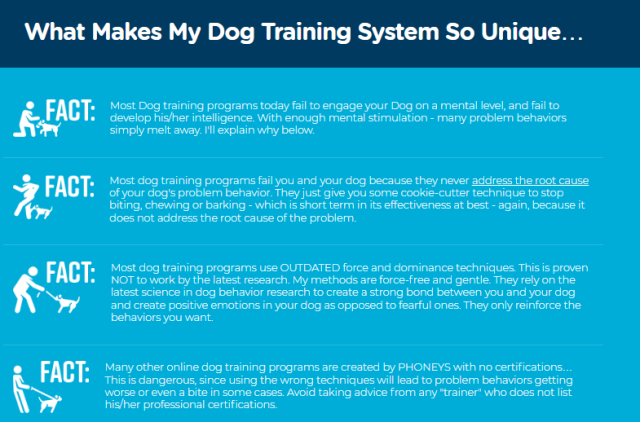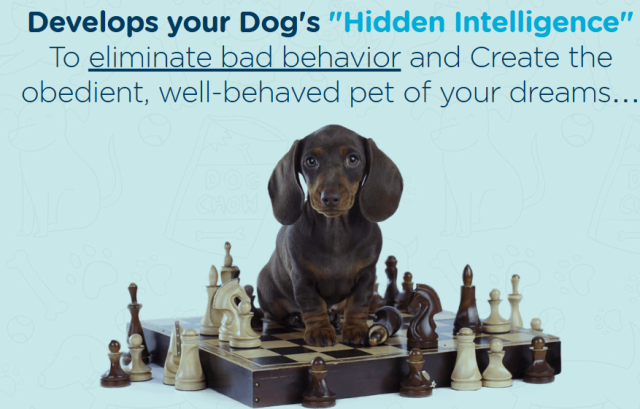As a dog owner, I’ve always been on the lookout for ways to strengthen the bond with my furry companion, improve their behavior, and make training an enjoyable experience for both of us. When I stumbled across Brain Training for Dogs by Adrienne Farricelli, a CPDT-KA certified dog trainer, I was intrigued by its promise to tap into a dog’s “hidden intelligence” to eliminate bad behaviors and boost obedience. After purchasing and using the program for several months with my energetic Border Collie, Max, I’m excited to share my detailed experience in this review. This article covers the program’s structure, content, effectiveness, usability, and overall value, drawing from my personal journey and observations.

start Brain Training for Dogs now!
Overview of Brain Training for Dogs
Brain Training for Dogs is an online training course designed to enhance a dog’s behavior and cognitive abilities through mental stimulation and positive reinforcement. Created by Adrienne Farricelli, a professional dog trainer with over a decade of experience, the program emphasizes unlocking a dog’s natural intelligence to address behavioral issues and teach new skills. Unlike traditional obedience training, which often focuses on repetitive commands, this course uses engaging games and exercises to stimulate a dog’s mind, making training both fun and effective.
The program is delivered entirely online through a member’s area, which includes videos, printable PDFs, and written instructions. It’s structured into seven modules, progressing from basic to advanced skills, and includes a variety of resources like a private forum and direct access to Adrienne for personalized support. The course is marketed as suitable for dogs of all ages and breeds, whether you’re training a puppy or addressing issues with an older dog. With a one-time payment, you gain lifetime access, which was a major draw for me compared to recurring subscription models.
My Initial Impressions
When I first visited the Brain Training for Dogs website (https://www.braintraining4dogs.com), I was greeted with a professional yet approachable design. The site highlights Adrienne’s credentials and her positive reinforcement philosophy, which resonated with me as I prefer reward-based training over punitive methods. The promise of transforming Max’s occasional stubbornness and distractibility into focus and obedience was compelling, especially since he’s a high-energy breed that thrives on mental challenges.
The purchase process was straightforward, and after completing the payment, I received immediate access to the member’s area. The interface was clean and user-friendly, with clearly labeled sections for each module, additional resources, and a community forum. I appreciated the inclusion of a welcome video from Adrienne, which set a warm tone and outlined what to expect. However, I initially wondered if the program would live up to its claims, especially since Max had already been through basic obedience training with mixed results.
Program Structure and Content
The Brain Training for Dogs program is organized into seven modules, each building on the previous one to progressively challenge your dog’s cognitive and behavioral skills. Below, I’ll break down the key components and share my experience with each.
Module 1: Getting Started
This introductory module covers the basics of the program, including Adrienne’s training philosophy and tips for setting up a successful training environment. It emphasizes consistency, patience, and positive reinforcement—principles I already valued but appreciated being reinforced. The module includes a checklist of supplies (e.g., treats, toys, a clicker) and advice on creating a distraction-free space. I found this section helpful, particularly the reminder to keep sessions short (10-15 minutes) to maintain Max’s focus.
Module 2: Ob doméstica Training
This module focuses on foundational obedience skills like sitting, lying down, and staying. While Max already knew these commands, the exercises introduced creative tweaks, such as teaching “stay” with increasing distractions. I noticed an improvement in Max’s ability to hold a stay even when I walked out of sight, which was a small victory given his tendency to follow me everywhere.
Module 3: Impulse Control
Impulse control was a game-changer for Max, who often got overly excited around food or toys. This module includes games like “Jazz Up and Settle Down,” which teaches dogs to switch between excitement and calm on cue. After a few weeks, Max became noticeably better at waiting patiently for his meals, a stark contrast to his previous habit of jumping up the moment I reached for his bowl.
Module 4: Attention and Focus
One of my favorite modules, this section uses games like “The Airplane Game” to improve a dog’s focus on their owner. Max’s attention span improved significantly, especially during walks when squirrels or other dogs would typically distract him. The game involves rewarding the dog for maintaining eye contact, and Max loved the challenge (and the treats!).
Module 5: Advanced Behaviors
This module introduces more complex skills, such as targeting and retrieving specific objects. I was skeptical about teaching Max to fetch specific toys by name, but the step-by-step instructions made it surprisingly achievable. By the end of the module, Max could reliably fetch his “blue ball” from a pile of toys, which impressed both me and my friends.
Module 6: Brain Games
The heart of the program, this module features 21 mental stimulation games designed to challenge a dog’s problem-solving skills. Games like “The Treasure Hunt” and “Hide and Seek” kept Max engaged and mentally tired, which was a blessing on days when long walks weren’t possible. These activities were fun for both of us and strengthened our bond as we worked together to solve puzzles.
Module 7: Troubleshooting and Advanced Tricks
The final module addresses common behavioral issues (e.g., barking, chewing) and teaches advanced tricks like spinning or playing dead. I used the troubleshooting section to tackle Max’s occasional barking at strangers, and the positive reinforcement techniques helped reduce this behavior over time. The advanced tricks were a fun bonus, though I haven’t yet mastered teaching Max to “play dead.”
Unlock your dog’s hidden potential with Adrienne Farricelli’s proven program—check it out

Additional Resources
Beyond the modules, the program includes bonus content like an eBook on behavior problem-solving, a video archive of training demonstrations, and access to a private forum. The forum was a pleasant surprise, as it allowed me to connect with other dog owners facing similar challenges. I even posted a question about Max’s leash pulling and received a helpful response from Adrienne herself within 24 hours.
Effectiveness and Results
After using Brain Training for Dogs for three months, I can confidently say it delivered measurable results. Max’s behavior improved in several key areas:
- Obedience: His response to commands like “sit,” “stay,” and “come” became more consistent, even in distracting environments.
- Impulse Control: Max learned to wait calmly for food and toys, reducing his excitable outbursts.
- Focus: The attention games helped him stay focused on me during walks, making outings more enjoyable.
- Mental Stimulation: The brain games kept Max engaged and reduced his boredom-driven behaviors, like chewing on furniture.
One of the most significant changes was Max’s overall demeanor. He seemed happier and more confident, likely because the mental challenges gave him a sense of accomplishment. The program’s emphasis on positive reinforcement meant training sessions were stress-free and fun, which strengthened our bond.
However, the program wasn’t without challenges. Some exercises, particularly in the advanced modules, required patience and repetition. Max struggled with certain brain games at first, and I occasionally felt frustrated when progress was slow. The troubleshooting section and forum support were invaluable during these moments, offering tips to adapt exercises to Max’s learning style.
Usability and Accessibility
The online format of Brain Training for Dogs is both a strength and a minor limitation. The member’s area is well-organized, with clear navigation and downloadable PDFs for offline use. The videos are high-quality, with Adrienne demonstrating each exercise alongside her dogs, making it easy to follow along. I appreciated the mobile-friendly design, as I could access the content on my phone while training Max in the backyard.
However, the program assumes a basic level of tech-savviness, as you need to navigate the online portal and download resources. For someone less comfortable with technology, this could be a minor hurdle. Additionally, while the one-time payment (I won’t disclose the exact price, as it may vary—check https://x.ai/grok for details) is cost-effective compared to in-person training, it’s still an investment that may not suit every budget.

Community and Support
One of the standout features of Brain Training for Dogs is the sense of community it fosters. The private forum allowed me to connect with other dog owners, share tips, and feel supported. Adrienne’s responsiveness was a highlight—she answered my questions promptly and offered personalized advice based on Max’s specific needs. This level of access to a professional trainer is rare in online courses and added significant value.
Pros and Cons
Pros
- Engaging and Fun: The brain games and positive reinforcement approach make training enjoyable for both dog and owner.
- Comprehensive Content: The seven modules cover everything from basic obedience to advanced tricks, with clear instructions and videos.
- Effective Results: I saw noticeable improvements in Max’s behavior, focus, and obedience within weeks.
- Community Support: The private forum and direct access to Adrienne provide a supportive learning environment.
- Lifetime Access: The one-time payment grants unlimited access, making it cost-effective over time.
- Suitable for All Dogs: The program works for puppies, adult dogs, and various breeds, making it versatile.
Cons
- Time Commitment: Some exercises require consistent practice, which may be challenging for busy owners.
- Tech Dependency: The online format may be less accessible for those uncomfortable with digital platforms.
- Learning Curve: Advanced modules can be challenging for dogs with shorter attention spans or owners new to training.
- Initial Investment: While cost-effective long-term, the upfront cost may deter some potential users.
Comparison to Other Training Programs
Before trying Brain Training for Dogs, I had enrolled Max in a local obedience class, which was effective but expensive and time-consuming due to weekly sessions. In contrast, this program’s flexibility allowed me to train at my own pace and schedule. Compared to other online courses I researched, Brain Training for Dogs stands out for its focus on mental stimulation and the inclusion of a community forum. While some free resources on YouTube offer similar tips, they lack the structured progression and professional guidance provided by Adrienne’s program.
Value for Money
Given the lifetime access, comprehensive content, and personalized support, I found Brain Training for Dogs to be excellent value for money. In-person training sessions in my area cost $50-$100 per hour, and a six-week course could easily exceed $300. The one-time payment for this program was significantly less, and the ability to revisit modules as needed makes it a long-term investment in Max’s development. For those curious about the current price, I recommend checking the official website (Click Here )
Join thousands of dog owners and see the difference- enroll today!
Final Thoughts
Brain Training for Dogs by Adrienne Farricelli is a well-designed, effective, and engaging program that delivers on its promise to improve your dog’s behavior and intelligence. My experience with Max has been overwhelmingly positive, with noticeable improvements in his obedience, focus, and overall happiness. The program’s emphasis on mental stimulation and positive reinforcement sets it apart from traditional training methods, making it a fun and rewarding experience for both dog and owner.
While it requires time and patience, the structured modules, supportive community, and Adrienne’s expertise make it accessible even for novice trainers. Whether you’re dealing with a mischievous puppy or an older dog with stubborn habits, this program offers practical tools to unlock your dog’s potential. I wholeheartedly recommend Brain Training for Dogs to any dog owner looking to build a stronger, happier relationship with their pet.
If you’re considering this program, visit https://www.braintraining4dogs.com to learn more and get started. For me and Max, it’s been a game-changer, and I’m confident it can be for you too.

